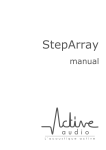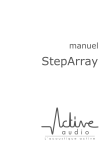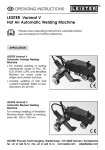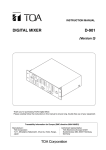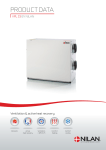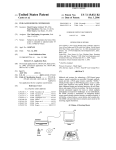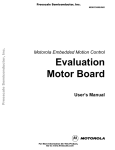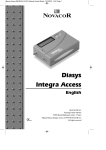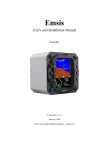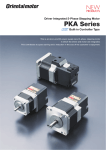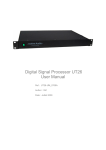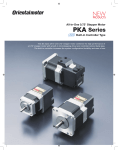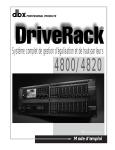Download here - Active Audio
Transcript
StepArray manual L ' a c o u s t i q u e a c t i v e CONTENTS Contents Contents 2 I 4 StepArray: tutorial for recommandation 1 Sound reinforcement in large spaces 5 2 Overview of the StepArray system 9 3 Choosing the right installation set-up 12 4 Column positionning rules 14 5 Options 16 6 SAdrive software 16 7 CAD modeling 17 References 18 II 20 StepArray technical reference 8 Installation of the columns 21 9 Wiring 22 10 Test before powering up 25 11 SAdrive software 26 12 Advanced functions 27 13 Troubleshooting 30 14 Hardware specifications 32 15 Acoustical data 37 List of Tables 44 List of Figures 44 2 CONTENTS Foreword StepArray is a versatile line-array system designed for speech reinforcement in large spaces. It offers excellent sound intelligibility, slim design, external electronics, security systems compatibility and more. This reference manual is intended to be a user manual for StepArray based systems, as well as a complete reference with all the technical specifications and details about the StepArray system. How to use this manual This reference manual is divided in two parts: • The first part is a tutorial for recommandation. It deals with StepArray design and principles, introducing the acoustic background necessary to understand sound reinforcement in large space, and how StepArray can help to achieve good intelligibility in these places. • The second part is a technical reference describing the full range of StepArray products. It covers installation, wiring, maintenance, and tuning. Extensive technical data is found there. Last update: December 23, 2010 3 Part I StepArray: tutorial for recommandation Table of Contents 1 2 3 Sound reinforcement in large spaces 5 1.1 General issues with public address in large spaces . . . . . . . . . . . . . . . . . . . . . 5 1.2 Loudspeaker arrays . . . . . . . . . . . . . . . . . . . . . . . . . . . . . . . . . . . . . 7 1.3 DGRC: The StepArray system . . . . . . . . . . . . . . . . . . . . . . . . . . . . . . . 8 Overview of the StepArray system 2.1 StepArray system example . . . . . . . . . . . . . . . . . . . . . . . . . . . . . . . . . . 10 2.2 StepArray column models . . . . . . . . . . . . . . . . . . . . . . . . . . . . . . . . . . 11 2.3 StepArray specificity: shared electronics . . . . . . . . . . . . . . . . . . . . . . . . . . 11 Choosing the right installation set-up 12 3.1 Columns . . . . . . . . . . . . . . . . . . . . . . . . . . . . . . . . . . . . . . . . . . . . 12 3.2 Processors . . . . . . . . . . . . . . . . . . . . . . . . . . . . . . . . . . . . . . . . . . . 13 3.3 Amplifiers . . . . . . . . . . . . . . . . . . . . . . . . . . . . . . . . . . . . . . . . . . . 13 3.4 Cables . . . . . . . . . . . . . . . . . . . . . . . . . . . . . . . . . . . . . . . . . . . . 14 3.5 Subwoofers . . . . . . . . . . . . . . . . . . . . . . . . . . . . . . . . . . . . . . . . . . 14 4 Column positionning rules 14 5 Options 16 5.1 Microphone (MIC) . . . . . . . . . . . . . . . . . . . . . . . . . . . . . . . . . . . . . . 16 5.2 Sub-bass Output (SUB) . . . . . . . . . . . . . . . . . . . . . . . . . . . . . . . . . . . 16 5.3 Sound Security System (SSS) . . . . . . . . . . . . . . . . . . . . . . . . . . . . . . . . 16 6 SAdrive software 16 7 CAD modeling 17 References 4 9 18 Introduction This is a tutorial for StepArray recommandation. Section 1 presents general issues about public address in large spaces (1.1) and explains how loudspeaker arrays can be a good solution to these issues (1.2). StepArray is introduced as the last point of this section (1.3). The following parts are a step by step introduction to the StepArray system: • Section 3 explains the rules to follow when designing a StepArray system, • Column positionning is described in section 4, • The different options are described in section 5, • SAdrive software, serving both as a simulation and tuning software, is described in section 6, • CAD modeling tools are presented in section 7. 1 1.1 Sound reinforcement in large spaces General issues with public address in large spaces Speech reinforcement in large and reverberant rooms is made difficult by several causes, namely reverberation, ambient noise, and architectural constraints. Reverberation In all rooms, sound transmission from a loudspeaker to a listener can be divided in two parts (figure 1): • Direct sound, which depends on the loudspeaker-to-listener distance and on the loudspeaker directivity. • Reverberated sound, which depends on the geometry of the room, and the acoustical properties of the walls. In large spaces (church, railway station), the reverberation can be very important and plays a negative role on speech intelligibility (Note that the energy of the reverberated sound is constant throughout the room). Reverberated sound Direct so und Figure 1: Direct sound increases speech intelligibility, reverberated sound impairs it. Intelligibility rule #1: Direct sound increases speech intelligibility, reverberated sound impairs it. Last update: December 23, 2010 5 1.1 General issues with public address in large spaces Ambient noise Ambiant noise reduces intelligibility. For example, the loud noise produced by trains in railway stations could prevent the listener from understanding a message properly. Also, the noise level can change drastically over time: in this case, the public address system must adjust its diffusion level according to the noise level. Intelligibility rule #2: The public address sound system should emit at least 10dB above the ambient noise level. Architectural constraints Loudspeakers positionning is often restricted by architectural or practical constraints. Because loudspeakers are not always welcome in places where aesthetics are important, they should be made discreet and as few as possible should be used. Speech intelligibility in large spaces As seen above, speech intelligibility1 depends on: • Reverberation time. This is a caracteristic of the room acoustics and depends on the material of the wall and the geometry of the room. • Direct Sound Reverberated Sound energy ratio. This depends on reverberation time, room volume2 , loudspeaker to listener distance, and loudspeaker directivity. • Signal Noise ratio. This depends on the ability of the sound system to emit enough energy to «cover the noise». In large spaces, changing the reverberation time involves changing a significant portion of the wall material, and most of the time, this is not possible. Providing a strong signal to noise ratio is also important, but it is not enough to ensure intelligibility. Therefore, in large and reverberant rooms, the most important parameter the public address must affect is the Direct Sound Reverberated Sound ratio. It is necessary to privilege the direct sound energy and avoid putting energy in the reverberated part of sound. This can be achieved either by moving the loudspeaker close to the listener, or by using highly directional loudspeakers. In a large and highly reverberant room, it is necessary to privilege the direct sound energy for good intelligibility results. In large spaces, if the loudspeakers are to be placed close to the listeners, many loudspeakers are required. This is not practical in such places because fixing loudspeakers can be difficult (very high ceiling, etc). Also, in many cases, this will not give good intelligibility results because only the loudspeakers close to the listener contribute to the direct sound, while all the loudspeakers contribute equally to the reverberated sound. 1 Several indexes have been proposed to measure speech intelligibility. The most widely used of them is the Speech Transmission Index (STI). Value 0 corresponds to extremely poor intelligibility, and value 1 corresponds to perfect intelligibility. It is generally considered that intelligibility is correct above STI=0.55. time 2 Energy of the reverberated field is proportionnal to the ratio Reverberation . Room volume 6 1.2 Loudspeaker arrays Using many non-directional loudspeakers often leads to poor intelligibility: all loudspeakers contribute to the reverberation, while only a few contribute to direct sound. Using highly directionnal loudspeakers is an easier solution in large spaces because only few diffusers are needed. In addition to improved acoustic performance and reduced cost, it minimizes the aesthetical impact of the public address system. Sound quality Intelligibility is not enough for good perceived sound quality. Another very important aspect is that every listener has an adequate sound pressure level (SPL), which implies that the public address system provides an even coverage of the audience area. This can be acheived with an accurate control of the loudspeaker directivity. Acoustic comfort also implies a wide frequency bandwidth and low harmonic distortion. The most important goal of a public address system is to provide a strong and constant direct sound over the entire audience area, and minimize the energy emitted elsewhere. 1.2 Loudspeaker arrays Loudspeaker arrays are often the best solution to providing strong and constant direct sound over the audience. Indeed, although a distributed public address system might yield a relatively constant SPL over the audience using a large number of loudspeakers, it is usually not able to provide satisfactory speech intelligibility when reverberation in the room is high. In addition, it usually has a rather negative impact on the visual aspect of the room. In contrast, high speech intelligibility can be obtained with a limited number of loudspeaker arrays (often only 1 or 2) in a large and highly reverberant room with minimum impact on the aesthetics of the room. It is easy to calculate the shape of the wave front that should be radiated by a loudspeaker array in order to yield constant SPL over the entire audience area, and minimize sound energy emitted elsewhere. A J-shape wave front is obtained, in which the local curvature depends on the focal distance, as illustrated on figure 2. In order to generate such a wave front, one can align loudspeakers along the J-shape as in geometric arrays (figure 3a on the following page) [C-HEIL], or place loudspeakers on a vertical line and rely on the filtering of each individual loudspeaker as in electronic arrays (figure 3b on the next page) [DSP directivity]. The latter case corresponds to column loudspeakers, which can be flush mounted on a wall. Advantages and disadvantages of both array types are discussed in [DGRC-Arrays]. Wave front r2 d2 r1 d1 x1 Listening plan x2 Figure 2: J-shape wave front required in order to radiate constant SPL over the listening plan. Last update: December 23, 2010 7 1.3 DGRC: The StepArray system The main characteristic of an array is its range, which corresponds to the minimum and maximum distance (from the column) where the SPL is constant (with a given tolerance). The range of a column is proportional to its height. Another important characteristic of an array is the spacing between loudspeakers. Good rejection of secondary lobes at high frequencies is obtained with a short spacing. At high frequencies, geometric arrays generally use waveguides that radiates like an isophase vertical slit. Aligning several of these waveguides yields a semi-continuous “line source”, which greatly reduces undesired secondary lobes. Signal Signal Wave front (a) In a geometric array, loudspeakers are aligned along the shape of the wave front to be generated, usually a J shape. D1 F1 G1 D2 F2 G2 D3 F3 G3 D4 F4 G4 D5 F5 G5 D6 F6 G6 Wave front (b) In an electronic array, loudspeakers are aligned vertically, and the wave front is synthesized by adequate filtering by filters Fi , delays Di , and gain Gi associated to each loudspeaker. Figure 3: Electronic and geometric arrays 1.3 DGRC: The StepArray system The StepArray columns implement the DGRC line-array principle (Digital and Geometric Radiation Control) which is a synthesis of geometric and electronic arrays patented by Active Audio. The principle is illustrated in figure 4 on the facing page. The key idea is to split the desired wave-front into sections and move them back on a vertical line, much like what is done in the Fresnel lenses used in optics. Then electronic delays are used to compensate sound propagation delay between the sections. It was shown in [DGRC-Arrays] that with this delay setting there is no diffraction at the edges of the saw-tooth shape. As a result of this principle, the number of DSP and amplification channels is independent of the number of loudspeakers, so that a dramatically reduced number of channels is achieved. 8 F1 D1 G1 A1 F2 D2 G2 A2 Wave front F3 D3 G3 A3 Input EQ signal di F4 D4 G4 A4 F5 D5 G5 A5 F6 D6 G6 A6 Figure 4: The DGRC principle used by StepArray columns. The wave front is controlled both by the positioning and orientation of the loudspeakers, and by filters Fi , delays Di , and gain Gi of each channel. The main advantages brought by the DGRC principle used in StepArray columns are: • The column is vertical and can be fitted close to the wall. • Reduced number of electronic channels, both for DSP and amplifiers. For example, model SA250P which is 2.5m high uses only 6 channels for 30 loudspeakers. This can make a big cost difference. • Power is uniformly distributed to all loudspeakers. This way they can all be used at their maximum capabilities, enhancing overall performance and sound pressure level. • The number of channels does not depend on the number of loudspeakers. Therefore, many small full-range loudspeakers can be used to obtain perfect sound quality in the treble range and reduce secondary lobes at higher frequencies. 2 Overview of the StepArray system The StepArray range consists of several column models dedicated to speech diffusion and to mid-power music diffusion in large and/or reverberant enclosed spaces. The different models allow coverage of flat or tilted audience area ranging from 15m to 68m with perfect speech intelligibility and high sound quality. Last update: December 23, 2010 9 2.1 StepArray system example StepArray columns use external electronics. They are controlled by the UT26 digital signal processor (DSP) and powered by the MPA6150 6-channel amplifier. Having external electronics has the following advantages: • Possibility to use a single UT26 processor controling several columns, yielding a large cost reduction (see section 2.3 on the next page). • Possibility to use several amplifiers for a single column in order to increase security: failure of one amplifier would only affect some of the channels, but the column continues to diffuse messages. For example, when using 2 columns and 2 amplifiers, amplifier 1 can be connected to channels 1, 3, 5 of both columns, and amplifier 2 to channels 2, 4, 6 of both columns. • Easier maintenance: all electronics can be easily accessed in the technical room. • Electronics can be placed in a fireproof room, with uninterruptible power supply (UPS). The operating parameters of the UT26 processors are tuned with the SAdrive software through RS232 serial communication. UT26 processors feature filtering functions such as the control of directivity, equalization, delay, and high level functions. In addition, the StepArray system features a set of options such as subwoofer output (SUB), active gain control (AGC), and security system supervision (SSS). 2.1 StepArray system example Figure 5 is an example of a complete StepArray installation. The audio signal is fed into the UT26 processors which then supply DGRC compatible signals to the MPA6150 amplifiers. A UT26 can also provide sub-bass output when equipped with the SUB option. The settings are made with the SAdrive software through an RS232 serial bus. SA250P 4x SA100P SA250P SA12-SWA 3x MPA6150 2x UT26 BAN RS232 Audio input Figure 5: Example of StepArray system 10 2.2 2.2 StepArray column models StepArray column models Table 1 on the next page and table 2 on page 13 give an overview of the StepArray models characteristics. A complete description of the technical characteristics can be found in sections 14 and 15. SA400P SA250P SA180P SA100P 3m 2.5m 30m 15m 35m 68m Floor Figure 6: Listening zones (P-models) SA250S SA180S or Flo 3.8m 2.6m 10° 4m 22m 28m Figure 7: Listening zones (S-models) Columns whose name ends with a «P» (SA100P for example) are designed for horizontal audience areas, whereas column whose name ends with a «S» are designed for tilted audience areas (or with balcony). 2.3 StepArray specificity: shared electronics One of the advantages of using external electronics is that several columns can be connected (via their amplifier) to the same UT26 processor. A UT26 processor features 6 analog symmetrical outputs. Therefore a single UT26 processor can be used to deliver signals for: • a 6 channel column, • one or two 3 channel columns. Moreover, a UT26 processor can be connected to one or several StepArray amplifiers (to feed several columns with the same signal). In this case, the inputs are simply daisy chained to the amplifiers (see section 9.1 on page 22). Last update: December 23, 2010 11 In the example installation figure 8, three independant rooms are equipped with StepArray columns. Each room receives its own signal and can have independant parameters. For a total of 6 columns, only 2 processors and 3 amplifiers are needed! Lounge: 2 x SA100P Conference room: 2 x SA180S Hall: 2 x SA250P + SUB 3x MPA6150 2x UT26 Lounge input Conference input Hall input Figure 8: Shared electronics example 3 Choosing the right installation set-up 3.1 Columns All StepArray columns feature a large frequency bandwidth and a wide horizontal opening angle3 . The columns are mounted vertically using the supplied square brackets. The columns are available in standard RAL colors RAL9016 and RAL9005, but any other RAL color is available with the COL option. Table 1 sums up these characteristics. Max SPL Hor. opening Bandwidth Mounting Colors 95dBSP L 180° (-6dB) 135Hz-17kHz (-3dB) 110Hz-19kHz (-10dB) Vertical (supplied square brackets) White RAL9016 Black RAL9005 Any RAL (COL option) (pink noise, in listening area) Table 1: General characteristics of StepArray columns. StepArray columns do not use opening angle and tilting angle to tune directivity. Instead, StepArray use the listening area definition to automatically adjust themselves as to fit the requirements to the best. StepArray columns use the listening area definition to automatically adjust themselves. 3 12 The horizontal opening angle corresponds to a 6dB attenuation for the average of the 1 kHz and 2 kHz octaves. 3.2 Processors The StepArray range provides a full set of listening ranges4 and audience tilting angles to suit any public address situation. The listening areas, as described on figure 9, are listed on table 2. The nominal situation corresponds to the conditions for which the column has been designed. By specifying the effective positioning of the column and the shape of the listening area in the Directivity bloc of SAdrive, the DSP filtering parameters are automatically adjusted to the situation. Choose the column which covers the most of the listening area. Liste h ning a r ea Floo r θ 0 Range dmin Figure 9: Listening area definition Model Height Nominal altitude h (standing/seated audience) Audience angle (θ ) Range 500Hz-2kHz (±3dB / ±5dB) Min. distance (dmin ) Channel count SA100P SA180P SA250P SA400P 1m 1.8m 2.5m 4m 2.5m / 2.1m 2.5m / 2.1m 2.5m / 2.1m 3.0m / 2.6m Flat (0-5°) Flat (0-5°) Flat (0-5°) Flat (0-3°) 15m / 21m 30m / 40m 35m / 45m 68m / 90m 1m 1m 1m 1m 3 3 6 6 SA180S SA250S 1.8m 2.5m 3.0m / 2.6m 4.2m / 3.8m Tilted (5-20°) Tilted (5-20°) 22m / 29m 28m / 36m 4m 4m 3 6 Table 2: Specific characteristics of StepArray column models. 3.2 Processors The UT26 processor has 6 output channels, therefore it can deliver signals for two 3 channel columns, or one 6 channel column. It is also possible to connect two 3 channel columns with different signals on the same processor to obtain a stereo sound. Independent settings are available for directivity, equalization, and delays. All these settings can be saved and recalled remotely thanks to presets. More details on wiring can be found in section 9.1. 3.3 Amplifiers The MPA6150 amplifier is capable of delivering 6 × 150 watts under 4Ω load, or 6 × 100 watts under 8Ω loads. More details on wiring can be found in section 9.1. 4 The range of a column is defined as the maximum distance from the column for which the mean sound level for the octaves 500Hz, 1 kHz, and 2 kHz remains within ±3dB or ±5dB . Last update: December 23, 2010 13 3.4 3.4 Cables Cables Cable lengths detailed in table 3 correspond to the maximum lengths recommended for the amplifier to column cable5 . Cable length Wire diameter < 300m < 500m 1.5mm2 2.5mm2 Table 3: Wiring recommendations for StepArray columns. For very long distances exceeding the maximum cable length mentioned in table 3, please contact Active Audio. • 3 channel columns need a 4 wire cable. • 6 channel columns need a 7 wire cable. 3.5 Subwoofers In cases where the StepArray system diffuses music, the sound fidelity will be better if a subwoofer and its associated amplifier are added. This option is not necessary for installations aimed at vocal diffusion since the human voice hardly has component frequencies in the bass range below 150 Hz. The subwoofer signal is delivered by an UT26 processor fitted with the SUB option (see section 5.2). Active Audio proposes subwoofers (SA12-SW and SA12-SWA) suitable for StepArray installations (see section 14.3). 4 Column positionning rules When choosing a StepArray setup, the goals are: • Ensuring proper SPL coverage, • Delivering satisfying intelligibility of vocal messages, • Avoiding echoes and feedback effects, • Giving the feeling that the sound comes from the speaker. The positioning of columns should follow a few basic rules: • Use as few columns as possible: choose the column covering as much of the listening area at once. • Add more columns only if necessary. Beware: intelligibility could be impaired if there are too many columns. • Columns should be placed so as to obtain the most homogeneous sound level over the audience area. • For complex cases, it is highly recommended to use CAD software which will take into account the acoustics of the room. CAD tools are presented in section 7. 5 14 These maximum cable lengths correspond to a sound level loss of 3dB. • Place the columns as close as possible to the nominal altitude (see table 2 on page 13). When placing columns at non nominal altitude, use SAdrive software to check that column emission will be acceptable. When dealing with several columns, the differences of propagation distances6 for columns covering the same listening area should be less than 20m. so as to avoid possible echoes for certain sections of the audience. See figure 10. Column 1 Column 2 If |d1-d2| < 20m, there is no echo d1 d2 Listening area Listener Figure 10: Interferences between columns Also, consider microphones and stage: • the speaker must be placed at less than 15 m from the columns, otherwise he will hear the echo of his own voice. • the audience must feel that the sound comes from the speaker. This is achieved by fitting a column on each side of the stage so as to «re-centre» the sound. A single column can be used but in this case it has to be close to the zone to be covered. • Prevent the feedback effect: there should never be a microphone aiming at a column; this could generate a feedback problem. The impact of the room acoustics on the sound level within the covered zone is relatively low a , since the fundamental aim of the StepArray columns is to provide a strong direct sound in order to ensure high intelligibility, even in reverberant spaces. a 6 SPL reinforcement by reverberation can be higher close to walls. In this context, propagation distance is the column to listener distance. Last update: December 23, 2010 15 5 Options Several options are available for the StepArray system. These options bring additional electronic cards within the UT26 processor and the columns. A marqued plaque on the back of the processor indicates the options as shown in figure 11. Serial number 137 CV232 SUB Audio Bus - BAN848 MIC SSS Active Audio UT26 Processing Unit - Made in France Local Bus - BCL Computer - RS232 Figure 11: Indication of options on the rear panel of the UT26 processor (CV232 only in this example). 5.1 Microphone (MIC) This option brings an electret microphone in the connection box at the back of the column, and its phantom power supply delivered through input 2 by the UT26 processor. This option is needed to enable the AGC (automatic gain control) function (section 12.1). 5.2 Sub-bass Output (SUB) When playing music, it is generally necessary to complement the columns with a sub-bass loudspeaker. The SUB option gives a sub-bass output on the BCL port of the UT26 processors (wiring is described in section 9.6). When using the SUB option, the subwoofer signal is low-pass filtered by the UT26 processor with a 4th order Linkwitz-Riley type at 180 Hz, and the column’s signal is filtered with the complementary high-pass filter. Note that for speech diffusion, there is no point extending the bass response. 5.3 Sound Security System (SSS) The SSS option (Sound Security System) brings EN-60849 conformance to a StepArray system. It is suitable for installations diffusing security messages. It consists of monitoring of proper functioning of the system as per the requirements of the norm, using two daughter boards inside the UT26 processor and a sensor for electric current measurement. Processor, amplifier, and speaker faults are detected. Beyond the norm: The SSS option is a great way to ease maintenance of an installation by keeping you informed of proper fonctionning. 6 SAdrive software The SAdrive software is primarly used to tune the operating parameters of StepArray columns, but it is also a great simulation tool. The software can be downloaded for free on Active Audio’s website: http://www.activeaudio.fr/en/gamme-steparray/sadrive 16 SAdrive provides access to a full range of operations including, for each column: • input selection with adujstable noise gate, • equalization: 6 fully parametric biquadratic filtering elements, • sub-bass output management, • delay, • directivity control, • automatic gain control management, These operations are directly accessible through the SAdrive Synoptic frame as shown on figure 12. Figure 12: Synoptic frame Additionally, it is possible to save and recall operating parameters in presets. The main feature of SAdrive is the directivity control block, which allows the user to change the radiation pattern of StepArray columns in real-time. This block is presented in figure 13. Figure 13: SAdrive directivity block 7 CAD modeling There are powerful CAD software tools that can predict the acoustics of a room and accurately model the radiation of loudspeaker arrays. These tools can calculate various acoustic index, such as reverberation time, sound pressure level, STI. . . In a loudspeaker array, all loudspeakers operate in a coherent way. This must be taken into account in the modeling. To do so, software modules (DLL) which enables the CAD tools to properly model the StepArray columns are included inCATT-Acoustic and EASE. Last update: December 23, 2010 17 REFERENCES Figure 14 shows examples of a modeling results for CATT-Acoustic and EASE. With the StepArray DLLs, the directivity parameters can be adjusted as can be done in real situation with the SAdrive software. (a) Example of RASTI modeling using software CATT-Acoustic®. (b) Balloon plot of SPL radiated in octave 1 kHz by column SA250S. Simulation with EASE®. Figure 14: Examples of a CAD modeling results. References [DGRC-Arrays] X. Meynial, «DGRC arrays : A synthesis of geometric and electronic loudspeaker arrays», AES 120th Convention. Preprint 6786, Paris May 2006. [C-HEIL] «Sound Wave Guide», US Patent # 5,163,167, Inventor : C. Heil, nov 10 1992. [DSP directivity] G.W.J. van Beuningen; E.W. Start; «Optimizing Directivity Properties of DSP Controlled Loudspeaker Arrays», Reproduced Sound 16 Conference, Stratford (UK) 17-19 Nov 2000, Institute of Acoustics. 18 StepArray Technical manual L ' a c o u s t i q u e a c t i v e Part II StepArray technical reference Table of Contents 8 Installation of the columns 21 9 Wiring 22 9.1 UT26 processor to amplifier . . . . . . . . . . . . . . . . . . . . . . . . . . . . . . . . . 22 9.2 Amplifier setup . . . . . . . . . . . . . . . . . . . . . . . . . . . . . . . . . . . . . . . . 22 9.3 Wiring amplifiers to columns . . . . . . . . . . . . . . . . . . . . . . . . . . . . . . . . 23 9.4 Wiring the microphone (MIC option) . . . . . . . . . . . . . . . . . . . . . . . . . . . . 23 9.5 RS232 wiring . . . . . . . . . . . . . . . . . . . . . . . . . . . . . . . . . . . . . . . . . 24 9.6 SUB wiring . . . . . . . . . . . . . . . . . . . . . . . . . . . . . . . . . . . . . . . . . . 25 10 Test before powering up 25 11 SAdrive software 26 11.1 Init new processors . . . . . . . . . . . . . . . . . . . . . . . . . . . . . . . . . . . . . . 26 11.2 Check connected processors . . . . . . . . . . . . . . . . . . . . . . . . . . . . . . . . . 27 12 Advanced functions 12.1 Automatic gain control: AGC . . . . . . . . . . . . . . . . . . . . . . . . . . . . . . . . 27 12.2 Security Sound System: SSS . . . . . . . . . . . . . . . . . . . . . . . . . . . . . . . . . 28 12.3 Feedback killer . . . . . . . . . . . . . . . . . . . . . . . . . . . . . . . . . . . . . . . . 29 12.4 Remote control . . . . . . . . . . . . . . . . . . . . . . . . . . . . . . . . . . . . . . . . 30 13 Troubleshooting 30 14 Hardware specifications 32 14.1 UT26 processor characteristics . . . . . . . . . . . . . . . . . . . . . . . . . . . . . . . 32 14.2 MPA6150 amplifier characteristics . . . . . . . . . . . . . . . . . . . . . . . . . . . . . 33 14.3 Subwoofers characteristics . . . . . . . . . . . . . . . . . . . . . . . . . . . . . . . . . . 34 14.4 Columns characteristics . . . . . . . . . . . . . . . . . . . . . . . . . . . . . . . . . . . 35 15 Acoustical data 20 27 37 15.1 Common data . . . . . . . . . . . . . . . . . . . . . . . . . . . . . . . . . . . . . . . . . 37 15.2 SA100P acoustical data . . . . . . . . . . . . . . . . . . . . . . . . . . . . . . . . . . . 38 15.3 SA180P acoustical data . . . . . . . . . . . . . . . . . . . . . . . . . . . . . . . . . . . 39 15.4 SA250P acoustical data . . . . . . . . . . . . . . . . . . . . . . . . . . . . . . . . . . . 40 15.5 SA400P acoustical data . . . . . . . . . . . . . . . . . . . . . . . . . . . . . . . . . . . 41 15.6 SA180S acoustical data . . . . . . . . . . . . . . . . . . . . . . . . . . . . . . . . . . . 42 15.7 SA250S acoustical data . . . . . . . . . . . . . . . . . . . . . . . . . . . . . . . . . . . 43 List of Tables 44 List of Figures 44 8 Installation of the columns StepArray columns are mounted verticaly, usually on a wall, using the supplied brackets. Figure 15 illustrates the steps to follow for column mounting. See also figure 25 on page 36 for technical drawings of the brackets. 1 2 x3 Place the 2 brackets on the wall using 8mm diameter screws Column height + 5mm x3 3 4 Ensure verticality Mount the column using the supplied nut and screw Figure 15: Column mounting on a wall It is important to ensure verticality when mounting StepArray columns. Last update: December 23, 2010 21 9 9.1 Wiring UT26 processor to amplifier A UT26 processor can be connected to one or several StepArray columns via amplifiers (see figure 16). When a UT26 is used with several amplifiers (to feed several columns with the same signal), the inputs are simply daisy chained (see figure 16b). UT26 6 XLR-F to WAGO MPA6150 UT26 6 XLR-F to WAGO MPA6150 MPA6150 (a) Direct wiring (b) Daisy chain wiring Figure 16: UT26 to MPA6150 wiring XLR-F to Wago cables use standard XLR wiring convention as shown in table 4. XLR Wago pin 1 pin 2 pin 3 Ground pin + pin - Table 4: XLR to Wago wiring. 9.2 Amplifier setup MPA6150 amplifiers should be tuned with all gains to max, and microswitches set for independent channels, as described in figure 17. All gains to max. 6 XLR-F to WAGO IN3 1 3 SOURCE STEREO IN4 BRIDGE 2 4 SOURCE Set all microswitches for 6 independent channels Figure 17: MPA6150 amplifier set-up 22 9.3 9.3 Wiring amplifiers to columns Wiring amplifiers to columns Wiring amplifiers to columns is straightforward: simply connect each channel of the MPA6150 amplifier to the corresponding channel of the column and provide a common ground, as illustrated by figure 18. 1+ 2+ 3+ 4+ 5+ 6+ 1+ 2+ 3+ Not Used Not Used GND SA180P SA100P SA250P GND 6 channel column cabling on MPA6150 amplifier CH1 CH2 + - - + 1+ GND 2+ CH3 CH1 Column output on channels 4, 5, 6 Column output on channels 1, 2, 3 CH4 CH3 + - - + CH4 CH5 + - - + 3+ GND CH6 + - - + 1+ 2+ CH2 CH3 CH4 + - - + + - - + 1+ GND 2+ 3+ 4+ CH5 CH6 + - - + 5+ 6+ 3+ 6 channels 3 channels Figure 18: MPA6150 to column wiring 9.4 Wiring the microphone (MIC option) The MIC option consists of a microphone integrated inside the column and a daughter board placed inside the UT26 processor, which supplies phantom power on input 2 of the processor. The microphone output of the column should be linked to input 2 of the UT26 processor using a shielded conductor pair. Wiring is described in table 5. GND Pin 1 + Pin 2 Pin 3 Table 5: Wiring of the microphone: standard XLR. Last update: December 23, 2010 23 9.5 9.5 RS232 wiring RS232 wiring Only one processor should be connected with RS232 to the computer. If there are several UT26 processors, then communication with all processors is possible when the BAN connectors are connected in daisy chain. This is illustrated in figure 19. Computer is connected to UT26 with CV232 option CV232 SUB CV232 SUB MIC SSS MIC SSS DB9 female-female null-modem cable BAN848 - Audio Bus UT26 processors are connected by the BAN Figure 19: RS232 wiring diagram RS232 wiring uses standard DB9 null-modem wiring as shown in figure 20. 6 7 8 9 1 5 2 4 3 3 4 2 5 1 9 8 7 6 Figure 20: RS232 wiring: standard DB9 null-modem. When several UT26 processors are used, they can be inter-connected by the BAN connector. In this case only one of the UT26 connected to the BAN must be fitted with the CV232 option. The CV232 option is disabled by putting the JP1 jumper of the CV232 board to «PC» position. When the distance between the computer and the processor is over 30 meters, it is possible to use an RS485 port connected to the command channel (GND on pin 1, - on pin 2, + on pin 15) of the BAN connector. In this case, the CV232 option is not needed. 24 9.6 9.6 SUB wiring SUB wiring When the UT26 processor is equipped with the SUB option (section 5.2), a sub-bass output is delivered on the BCL port of the UT26 processor. Table 6 describes the wiring used. Pin Sig pin 5 pin 6 pin 14 + Ground Table 6: SUB wiring on BCL port. 10 Test before powering up Before powering up an installation, it is good practice to ensure that the column cable is properly connected to the column. Therefore, the electrical resistance of each channel of the column must be controlled at the end of the cable connected to the amplifier side. The measured electrical resistances values must correspond to the values below. Channel 1 2 3 4 5 6 SA100P 6.6Ω 6.6Ω 6.6Ω SA180P 6.6Ω 6.6Ω 6.6Ω SA250P 6.6Ω 6.6Ω 6.6Ω 4.4Ω 4.4Ω 4.4Ω SA400P 6.6Ω 6.6Ω 6.6Ω 6.6Ω 6.6Ω 6.6Ω SA180S 6.6Ω 6.6Ω 6.6Ω SA250S 3.3Ω 6.6Ω 6.6Ω 4.4Ω 4.4Ω 3.3Ω For details on connector pin assignement, see figure 18 on page 23. When measuring the electrical resistance, the cable resistance must be taken into account (about 1.3Ω for 100 meters of 1.5mm2 ; 0.7Ω for 100 meters of 2.5mm2 ). Last update: December 23, 2010 25 11 SAdrive software The SAdrive software is used to tune all the filtering parameters of StepArray columns, it is available as free download here: http://www.activeaudio.fr/en/gamme-steparray/sadrive 11.1 Init new processors When a new processor (factory settings) is first connected to SAdrive, it needs to be initiated. The initalization steps are described below. 1 2 Log in administrator mode. Switch OFF all processors OFF UT26 UT26 OFF 3 4 Connect to COM port Switch ON the processor connected with CV232 ON UT26 UT26 OFF 5 6 Set initial parameters for this processor, then apply. Switch ON one more processor. ON UT26 UT26 ON Remember: Switch ON one processor at a time. 7 8 Set initial parameters for this processor, then apply. Processor address must be unique. Repeat step 6 and 7 for each other processor. 26 Save as boot setup to make all changes permanent. 11.2 11.2 Check connected processors Check connected processors Already inited processors don’t show up automatically in SAdrive. To discover those processors, follow the steps below: 1 2 Connect to COM port. 12 Discover from harware setup. Advanced functions 12.1 Automatic gain control: AGC Automatic Gain Control is available if the UT26 processor is equipped with the MIC option (section 5.1). AGC allows automatic adjustment of the diffusion level according to the sound level captured by the microphone when no message is played. Using this function, the sound level perceived by listeners is adjusted for optimal comfort: moderate level when the ambiant noise is low, higher level when the ambiant noise is high in order to provide good intelligibility. The amplitude of the ambiant noise captured by the microphone is smoothed with a time constant adjustable by the user. This resulting smoothed value is used as a basis for gain calculation: below a threshold adjustable by the user, the AGC gain is set to 0dB ; above this threshold, the AGC gain increases proportionally to the ambiant noise up to +12dB . For example: • If the ambiant noise is 75dBSP L and the AGC enters in action (Threshold) at 65dBSP L , then the AGC gain will be 10dB (i.e. 75dB − 65dB ). • If the ambiant noise is 80dBSP L , and the AGC enters in action (Threshold) at 65dBSP L , then the AGC gain will be 12dB (i.e. 80dB − 65dB = 15dB but AGC gain is 12dB max) . The AGC algorithm is summarized on figure 21. AGC gain (dB) 12 0 Ambiant noise (dB spl) Threshold Threshold + 12dB Figure 21: Automatic gain control functional graph Last update: December 23, 2010 27 12.2 Security Sound System: SSS • When the AGC function is used, the Input selection of the Input block is forced to Input 1 type analog. • The ambiant noise value is displayed (by steps of 2dB ) in the Status frame of SAdrive. 12.2 Security Sound System: SSS Security Sound System conformance is available when the UT26 processor is equipped with the SSS option. This option includes: • daughter boards in the UT26 processor, • a push button with 2 LEDS on the front panel of the UT26 processor, • an SSS sensor box The SSS principle of operation is to use a probe signal along with a current sensor to monitor effective current consumption of each channel of the system. A UT26 processor equipped with the SSS option adds a high-frequency sine component to the audio signal output, and synchronously detects this high-frequency signal on its analog input 2 (where the SSS box is connected). This loopback allows precise monitoring of the current consummed by the columns. The cabling diagram for an SSS installation is shown in figure 22. UT26 1 2 3 4 5 6 6 5 4 3 2 1 SSS sensor MPA6150 (optional) Ambiant mic To In2 UT26 Front From/To SSS sensor CH1 GND CH3 CH5 CH6 + - - + 2+ 3+ 4+ 5+ 6+ 1 2 3 4 5 6 6 5 4 3 2 1 To amp. GND From col. GND SSS sensor wiring MPA6150 to column with SSS Figure 22: SSS cabling diagram 28 CH4 + - - + Out 1+ Rear CH2 + - - + Mic In 12.3 Feedback killer Any malfunction detected by the processor will have the following effects: • red LED is turned ON on UT26 front panel, • processor beeps • SSS contact between pins 1 and 9 is open on the BCL port of the UT26 processor is open. If the UT26 processor fails, the beep and LED signals won’t work, but the SSS contact will still be opened, so that the failure is reported to the central monitoring system of the installation. The SSS contacta is the primary indication for failure: it will be opened even if the processor fails (on missing power supply for example), so that failure is always reported. a SSS contact is between pins 1 and 9 on the BCL port of UT26 processor Examples of malfunctions: • a column channel is disconnected from the amplifier, • amplifier is off, • a gain on the amplifier was changed by mistake, • a loudspeaker burned, • the column cable is cut, • etc. 12.3 Feedback killer The feedback killer used in the UT26 processors is a modulated delay. The delay is modulated sinusoidally with a constant depth of 2.6ms, while the modulation frequency is adjustable for more or less agressive feedback elimination. The variation frequency is as follows: • Off : no modulation. • Low: 0.6Hz modulation frequency. • Mid: 1.3Hz modulation frequency. • High: 4.0Hz modulation frequency. On-site measurements indicate that the gain margin can usually be increased by 4dB. • The feedback killer maybe used for speech diffusion, but should be switched off for music diffusion. • The time variant nature of the algorithm used is not compatible with standard anti-larsen products. Last update: December 23, 2010 29 12.4 12.4 Remote control Remote control It is possible to control UT26 processors using a remote controller. The only requirement is being able to send hexadecimal code on RS232 connection. For example, remote controller model Extron MLC-104 can be configured to control UT26 processors. Table 7 present the list of accessible operations with their corresponding hexadecimal code Operation Mute Un-Mute Increase gain (+2dB) Decrease gain (-2dB) Load preset 1 Load preset 2 Load preset 3 Load preset 4 Hexadecimal code $81 $82 $83 $84 $85 $86 $87 $88 Table 7: Remote control character codes 13 Troubleshooting Symptom Possible cause Solution The green switch of the A fuse is burned Replace fuses in power supply UT26 processor is not ON connector at the back of UT26 processor (160mA delayed fuses) No sound comes out of the No input signal detected column. Check that the Sig LED is ON in SAdrive’s Status frame. If the LED is OFF, check that the Input threshold is not too high. The UT26 processor is not inited. Follow the steps presented in section 11.1 on page 26 to init processors with SAdrive. SAdrive does find the UT26 processor The computer to UT26 cable is Check that RS232 cable is wired as defective. described in section 9.5 on page 24. The UT26 processor is not equipped Connect the UT26 processor through with the CV232 option. the BAN to a UT26 processor equiped with the CV232 option as explained in section 9.5 on page 24. The COM port selected in SAdrive is Select the correct COM port in SAdrive wrong (Administration→Choose COM port) The processor is already inited Use menu Active Setup→Discover from Hardware to discover inited processors (see also section 11.2 on page 27). The sound is not homogeneous or distorted 30 Amplifier to column connection is Make sure columns are properly incorrect connected, as described in section 10 on page 25. Symptom Possible cause Solution Input signal level is too high Reduce input signal level (Max signal input is ±3.25V as described in 14.1 on the next page). Filtering parameters are wrong Reduce the gain (Mixer Block). Correct the equalization. The column is a pre-2010 column Check the tick-box using the menu: Active Setup→Manage processors. In the Options frame, use more... then specifiy if the column is a pre-2010 one. There is a wiring problem. Make sure the wiring is correct (see 10 The parameters of the Directivity block Check that listening area defined in the are wrong Directivity block of SAdrive matches on page 25). real situation (see figure 9 on page 13). The column model in SAdrive doesn’t Correct the column model using the match the real column model. menu Active Setup→Manage processors. No bass signal on SUB The SUB option has not been selected Check the SUB option using menu output in SAdrive Active Setup→Manage processors. The AGC function is not The MIC option has not been selected Check the MIC option using menu accessible and the Noise in SAdrive Active Setup→Manage processors. The AGC function doesn’t The microphone is not properly Make sure the microphone is properly work and the Noise field in connected to input 2 of the UT26 connected on input 2 of an UT26 the frame Status shows processor. equipped with the MIC option (see field in the status frame shows «–» «40dB» Last update: December 23, 2010 section 9.4 on page 23 for wiring). 31 14 14.1 Hardware specifications UT26 processor characteristics Audio data Analog inputs 2 symmetrical inputs, connectors XLR-F Max input voltage: ±3.25V (+9.5dBU) 1st order high pass cutoff at 6Hz. Crosstalk : < -90dB. Input impedance : 15 kΩ with option MIC, input 2 delivers a 14V phantom power supply. Digital input AES/EBU, 48kHz Analog outputs 6 symmetrical outputs, connectors XLR-M Max output voltage : ±1.6V (+3.3dBU , i.e. max input of MPA6150 amplifier). Output impedance : 46 Ω Dynamic range : 95 dB Sub-bass output (option) Symmetrical output on DB25 female BCL port 4th order Likwitz-Riley lowpass filter at 180Hz Max output voltage : ±1.6V (+3.3dBU ) General data 32 Communication RS232 port at 38400 bauds Mains 230V / 50Hz, 15W max Power consumption 45W Dimensions 430 × 44 × 285mm (Rack 19" - 1U) Color Black Weight 4kg 14.2 14.2 MPA6150 amplifier characteristics MPA6150 amplifier characteristics Audio data Operating modes 6 independent channels 3 independent channels (bridged) 2 x 3 channels (in1→out 1,2,3 ; in2→ out 4,5,6) Power 6 x 100 W under 8Ω, 6 x 150W under 4Ω 3 x 300W under 8Ω (bridged) Power consumption Typical: 100W ; Max 1kW. Analog inputs 6 symmetrical analog inputs. Phoenix connectors Outputs 6 outputs on screw terminals Frequency response 20Hz - 20kHz @ 1W ±1dB Input Impedance 10kΩunbalanced, 20kΩ balanced Sensitivity 1Vef f Signal-to-noise ratio 95dB Damping factor > 300 Gain Adjustable with 6 knobs on rear panel. Max voltage gain: 28dB . Harmonic Distortion THD : 0,1 % @ 1kHz General data Cooling Variable speed fan Protection Protection against overload and overheat Indicators Clip and Protect LEDs Dimensions 483 × 88 × 420mm (Rack 19" – 2U) Weight 12.3kg For further information, see the MPA6150 owner’s manual. Last update: December 23, 2010 33 14.3 14.3 Subwoofers characteristics Subwoofers characteristics Acoustical data Frequency bandwidth 40-500Hz Type Bass-Reflex Max SPL at 1m 130dB (Peak) Sensitivity 97dB / 1W / 1m Directivity Omnidirectionnal Loudspeaker 12", neodymium Electrical data Power handling 450W AES Inputs SA12 SW: Dual Speakon SA12 SWA: 2x XLR sym. 0dBV Impedance 8Ω Amplification SA12 SW: Compatible with MPA 6150 amplifier SA12 SWA: Digital amplifier Class D Electrical connection7 Neutrik Powercon, 195V - 250V AC 50-60Hz Mechanical data Materials Plywood Dimensions 435 × 400 × 440mm Weight SA12-SW : 18.5kg SA12-SWA : 19.8kg Color Black Tuning and exploitation Software Supplied SAdrive software: Filtering processor: UT26 with SUB option (dB) FR filtered by processor UT26 FR at 1m 5 0 −5 −10 −15 −20 −25 −30 50 2 100 10 Frequency (Hz) 200 Figure 23: SA12-SW frequency response. 7 34 Only for SA12-SWA 14.4 14.4 Columns characteristics 14.4.1 Electrical characteristics of StepArray columns Channel 1 2 3 4 5 6 SA100P SA180P SA250P SA400P SA180S SA250S 6.6Ω 6.6Ω 6.6Ω 6.6Ω 6.6Ω 3.3Ω 6.6Ω 6.6Ω 6.6Ω 6.6Ω 6.6Ω 6.6Ω 6.6Ω 6.6Ω 6.6Ω 6.6Ω 6.6Ω 6.6Ω 4.4Ω 6.6Ω 4.4Ω 4.4Ω 6.6Ω 4.4Ω 4.4Ω 6.6Ω 3.3Ω Columns characteristics Table 9: DC resistance of StepArray columns. For details on connector pin assignement, see figure 18 on page 23 in section 9.3. 14.4.2 Mechanical characteristics of StepArray columns D W L 34mm to 55mm Figure 24: StepArray column dimensions Last update: December 23, 2010 35 14.4 Model Dimensions (L×W×D mm) SA100P SA180P SA180S SA250P SA250S SA400P 1024 × 124 × 131 1840 × 124 × 135 1840 × 124 × 135 2505 × 124 × 159 2505 × 124 × 159 4096 × 124 × 135 Weight (net/shipping) 9kg / 12kg 17kg / 21kg 17kg / 21kg 24kg / 29kg 24kg / 29kg 39kg / 46kg Columns characteristics Cable 4G 4G 4G 7G 7G 7G Table 10: Mechanical and electrical characteristics of StepArray columns More precise schematics are available on Active Audio’s website in several formats: http://www.activeaudio.fr/en/gamme-steparray/catalogue-et-telechargements Fixing brackets ϕ11 25 121.51 25 14.4.3 35.65 96.51 82.89 5 ϕ8.5 11 11 34.42 71.22 11 11 M4 Red is bottom bracket only Figure 25: Fixing brackets for wall mounting of StepArray columns. 36 15 Acoustical data All data presented below is obtained with columns in their nominal position and using nominal DSP filtering parameters (flat EQ, etc). 15.1 Common data 10 5 amplitude (dB) 0 −5 −10 −15 −20 −25 −30 2 10 3 4 10 frequency (Hz) 10 Figure 26: Frequency response (column SA250P). Average of the mesurements at 7, 10, 15, 20, 25, and 30m. In red: with bass high-pass on position «100Hz», in blue: with bass high-pass on position «200Hz». 500Hz 1kHz 2kHz 4kHz 8kHz 0 30 330 -10dB 60 300 -20dB 90 270 Figure 27: Horizontal directivity (column SA250P) Last update: December 23, 2010 37 15.2 15.2 SA100P acoustical data SA100P acoustical data8 10dB 10m 5dB 0dB -5dB h=2,55m -10dB -15dB 0m 10m 20m -20dB (a) SA100P vertical directivity: sound level for the voice octaves (500Hz,1kHz,2kHz) in the vertical median plane. 10dB 5dB 0dB 10m -5dB -10dB -15dB -20dB 0m 10m 20m (b) SA100P horizontal directivity: sound level for the voice octaves (500Hz,1kHz,2kHz) on the listening plane. SPL(dist) SA100P 15 250Hz 500Hz 1000Hz 2000Hz 4000Hz 8000Hz 10 5 0 −5 −10 −15 0 2 4 6 8 10 12 14 16 18 20 (c) Sound level by octave in the axis of the listening plane in front of the column with respect to the distance from the column. Figure 28: SA100P acoustical data. 8 38 Column is in nominal position. Levels are referenced to the mean SPL on the listening area. 15.3 15.3 SA180P acoustical data SA180P acoustical data9 10dB 10m 5dB 0dB -5dB h=2,55m -10dB -15dB 0m 10m 20m 30m 40m -20dB (a) SA180P vertical directivity: sound level for the voice octaves (500Hz,1kHz,2kHz) in the vertical median plane. 10dB 5dB 20m 0dB -5dB -10dB 10m -15dB -20dB 0m 10m 20m 30m 40m (b) SA180P horizontal directivity: sound level for the voice octaves (500Hz,1kHz,2kHz) on the listening plane. SPL(dist) SA180P 15 250Hz 500Hz 1000Hz 2000Hz 4000Hz 8000Hz 10 5 0 −5 −10 −15 0 5 10 15 20 25 30 35 (c) Sound level by octave in the axis of the listening plane in front of the column with respect to the distance from the column. Figure 29: SA180P acoustical data. 9 Column is in nominal position. Levels are referenced to the mean SPL on the listening area. Last update: December 23, 2010 39 15.4 15.4 SA250P acoustical data SA250P acoustical data10 10dB 10m 5dB 0dB -5dB h=2,55m -10dB -15dB 0m 10m 20m 30m 40m 50m (a) SA250P vertical directivity: sound level for the voice octaves (500Hz,1kHz,2kHz) in the vertical median plane. 10dB 5dB 20m 0dB -5dB -10dB 10m -15dB -20dB 0m 10m 20m 30m 40m 50m (b) SA250P horizontal directivity: sound level for the voice octaves (500Hz,1kHz,2kHz) on the listening plane. SPL(dist) SA250P 15 250Hz 500Hz 1000Hz 2000Hz 4000Hz 8000Hz 10 5 0 −5 −10 −15 0 5 10 15 20 25 30 35 40 45 (c) Sound level by octave in the axis of the listening plane in front of the column with respect to the distance from the column. Figure 30: SA250P acoustical data. 10 40 Column is in nominal position. Levels are referenced to the mean SPL on the listening area. -20dB 15.5 15.5 SA400P acoustical data SA400P acoustical data11 10dB 10m 5dB 0dB -5dB h=3,05m -10dB -15dB 0m 10m 20m 30m 40m 50m 60m 70m -20dB (a) SA400P vertical directivity: sound level for the voice octaves (500Hz,1kHz,2kHz) in the vertical median plane. 10dB 40m 5dB 30m 0dB -5dB 20m -10dB 10m -15dB -20dB 0m 10m 20m 30m 40m 50m 60m 70m (b) SA400P horizontal directivity: sound level for the voice octaves (500Hz,1kHz,2kHz) on the listening plane. SPL(dist) SA400P 15 250Hz 500Hz 1000Hz 2000Hz 4000Hz 8000Hz 10 5 0 −5 −10 −15 0 10 20 30 40 50 60 70 (c) Sound level by octave in the axis of the listening plane in front of the column with respect to the distance from the column. Figure 31: SA400P acoustical data. 11 Column is in nominal position. Levels are referenced to the mean SPL on the listening area. Last update: December 23, 2010 41 15.6 15.6 SA180S acoustical data SA180S acoustical data12 10dB 10m 5dB 0dB -5dB SA180S h=2,65m -10dB -15dB 0m 10m 20m -20dB (a) SA180S vertical directivity: sound level for the voice octaves (500Hz,1kHz,2kHz) in the vertical median plane. 10dB 5dB 10m 0dB -5dB -10dB -15dB -20dB 0m 10m 20m (b) SA180S horizontal directivity: sound level for the voice octaves (500Hz,1kHz,2kHz) on the listening plane. SPL(dist) SA180S 15 250Hz 500Hz 1000Hz 2000Hz 4000Hz 8000Hz 10 5 0 −5 −10 −15 0 5 10 15 20 25 (c) Sound level by octave in the axis of the listening plane in front of the column with respect to the distance from the column. Figure 32: SA180S acoustical data. 12 42 Column is in nominal position. Levels are referenced to the mean SPL on the listening area. 15.7 15.7 SA250S acoustical data SA250S acoustical data13 10dB 10m 5dB 0dB SA250S h=3,85m -5dB -10dB -15dB 0m 10m 20m -20dB (a) SA250S vertical directivity: sound level for the voice octaves (500Hz,1kHz,2kHz) in the vertical median plane. 10dB 5dB 0dB 10m -5dB -10dB -15dB -20dB 0m 10m 20m (b) SA250S horizontal directivity: sound level for the voice octaves (500Hz,1kHz,2kHz) on the listening plane. SPL(dist) SA250S 15 250Hz 500Hz 1000Hz 2000Hz 4000Hz 8000Hz 10 5 0 −5 −10 −15 0 5 10 15 20 25 30 (c) Sound level by octave in the axis of the listening plane in front of the column with respect to the distance from the column. Figure 33: SA250S acoustical data. 13 Column is in nominal position. Levels are referenced to the mean SPL on the listening area. Last update: December 23, 2010 43 LIST OF TABLES List of Tables 1 General characteristics of StepArray columns. . . . . . . . . . . . . . . . . . . . . . . . . . . . . . 12 2 Specific characteristics of StepArray column models. . . . . . . . . . . . . . . . . . . . . . . . . . 13 3 Wiring recommendations for StepArray columns. . . . . . . . . . . . . . . . . . . . . . . . . . . . 14 4 XLR to Wago wiring. . . . . . . . . . . . . . . . . . . . . . . . . . . . . . . . . . . . . . . . . . . 22 5 Wiring of the microphone . . . . . . . . . . . . . . . . . . . . . . . . . . . . . . . . . . . . . . . . 23 6 SUB wiring on BCL port. . . . . . . . . . . . . . . . . . . . . . . . . . . . . . . . . . . . . . . . . 25 7 Remote control character codes . . . . . . . . . . . . . . . . . . . . . . . . . . . . . . . . . . . . 30 9 DC resistance of StepArray columns. . . . . . . . . . . . . . . . . . . . . . . . . . . . . . . . . . 35 10 Mechanical and electrical characteristics of StepArray columns . . . . . . . . . . . . . . . . . . . . 36 List of Figures 44 1 Direct sound increases speech intelligibility, reverberated sound impairs it. . . . . . . . . . . . . . . 5 2 J-shape wave front . . . . . . . . . . . . . . . . . . . . . . . . . . . . . . . . . . . . . . . . . . . 7 3 Electronic and geometric arrays . . . . . . . . . . . . . . . . . . . . . . . . . . . . . . . . . . . . 8 4 DGRC principle . . . . . . . . . . . . . . . . . . . . . . . . . . . . . . . . . . . . . . . . . . . . . 9 5 Example of StepArray system . . . . . . . . . . . . . . . . . . . . . . . . . . . . . . . . . . . . . 10 6 Listening zones (P-models) . . . . . . . . . . . . . . . . . . . . . . . . . . . . . . . . . . . . . . 11 7 Listening zones (S-models) . . . . . . . . . . . . . . . . . . . . . . . . . . . . . . . . . . . . . . 11 8 Shared electronics example . . . . . . . . . . . . . . . . . . . . . . . . . . . . . . . . . . . . . . 12 9 Listening area definition . . . . . . . . . . . . . . . . . . . . . . . . . . . . . . . . . . . . . . . . 13 10 Interferences between columns . . . . . . . . . . . . . . . . . . . . . . . . . . . . . . . . . . . . 15 11 Rear panel of the UT26 processor . . . . . . . . . . . . . . . . . . . . . . . . . . . . . . . . . . . 16 12 Synoptic frame . . . . . . . . . . . . . . . . . . . . . . . . . . . . . . . . . . . . . . . . . . . . . 17 13 SAdrive directivity block . . . . . . . . . . . . . . . . . . . . . . . . . . . . . . . . . . . . . . . . 17 14 Examples of a CAD modeling results. . . . . . . . . . . . . . . . . . . . . . . . . . . . . . . . . . 18 15 Column mounting on a wall . . . . . . . . . . . . . . . . . . . . . . . . . . . . . . . . . . . . . . 21 16 UT26 to MPA6150 wiring . . . . . . . . . . . . . . . . . . . . . . . . . . . . . . . . . . . . . . . 22 17 MPA6150 amplifier set-up . . . . . . . . . . . . . . . . . . . . . . . . . . . . . . . . . . . . . . . 22 18 MPA6150 to column wiring . . . . . . . . . . . . . . . . . . . . . . . . . . . . . . . . . . . . . . . 23 19 RS232 wiring diagram . . . . . . . . . . . . . . . . . . . . . . . . . . . . . . . . . . . . . . . . . 24 20 RS232 wiring: standard DB9 null-modem. . . . . . . . . . . . . . . . . . . . . . . . . . . . . . . . 24 LIST OF FIGURES 21 Automatic gain control functional graph . . . . . . . . . . . . . . . . . . . . . . . . . . . . . . . . 27 22 SSS cabling diagram . . . . . . . . . . . . . . . . . . . . . . . . . . . . . . . . . . . . . . . . . . 28 23 SA12-SW frequency response. . . . . . . . . . . . . . . . . . . . . . . . . . . . . . . . . . . . . 34 24 StepArray column dimensions . . . . . . . . . . . . . . . . . . . . . . . . . . . . . . . . . . . . . 35 25 Fixing brackets for wall mounting of StepArray columns. . . . . . . . . . . . . . . . . . . . . . . . . 36 26 Frequency response (column SA250P) . . . . . . . . . . . . . . . . . . . . . . . . . . . . . . . . 37 27 Horizontal directivity (column SA250P) . . . . . . . . . . . . . . . . . . . . . . . . . . . . . . . . 37 28 SA100P acoustical data. . . . . . . . . . . . . . . . . . . . . . . . . . . . . . . . . . . . . . . . . 38 29 SA180P acoustical data. . . . . . . . . . . . . . . . . . . . . . . . . . . . . . . . . . . . . . . . . 39 30 SA250P acoustical data. . . . . . . . . . . . . . . . . . . . . . . . . . . . . . . . . . . . . . . . . 40 31 SA400P acoustical data. . . . . . . . . . . . . . . . . . . . . . . . . . . . . . . . . . . . . . . . . 41 32 SA180S acoustical data. . . . . . . . . . . . . . . . . . . . . . . . . . . . . . . . . . . . . . . . . 42 33 SA250S acoustical data. . . . . . . . . . . . . . . . . . . . . . . . . . . . . . . . . . . . . . . . . 43 Last update: December 23, 2010 45 www.activeaudio.fr 332 Bd Marcel Paul, CP602 - 44806 Saint-Herblain Cedex - France Tel: +33 (0)2 40 92 39 90 - Fax: +33 (0)2 40 92 39 91 Contact














































